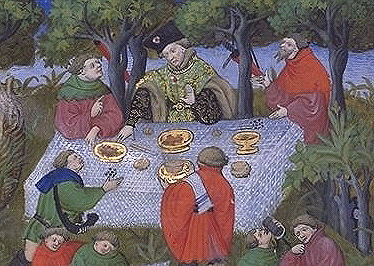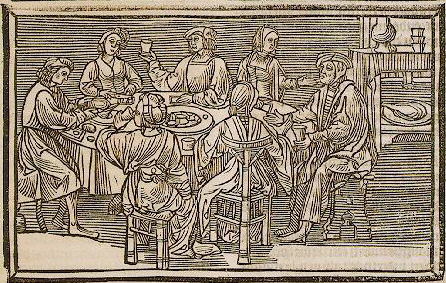![]()
![]()
![]()
A Chaucerian Feast Part 2. Mete and Drynke; Maketh Feeste
![]()
![]()

"It snewed in his hous of mete and drynke" - Prologue to The Canterbury Tales
Now, what menu to choose for A Chaucerian Feast? For a complete list of the foods Chaucer mentions in his writings, refer to Chaucer's Foods, Part 3 of A Chaucerian Cookery. Here you will find apples, grapes, bread, wine, ale, honey, capon, beef, and all sorts of foods that need little or no explanation. There are also, however, dishes that are very specific, such as mortreux and blankmanger, which are no longer familar in the 20th century. These true Medieval favorites must play an important part in any recreated Chaucerian feast, along with the more simple, familiar foods. And with the modern sources mentioned previously, it's possible to find many different recipes that correspond exactly to Chaucer's bake mete, chiknes with the marybones, and the other edibles of his characters. A Chaucerian feast can contain any number of these dishes, in any of their variations - blankmanger was made with fish or chicken, or as a sweet almond dessert; meat pies were concocted in infinite variations; and, of course, there were many ways to roast goose or cook fish. The final decision in all these matters is, of course, the cook's. Keeping cost, availability, and the type of guests being served in mind, one can be creative and present a dozen such feasts, each different from the other.
In the sample feast presented here are found all the specifically named dishes, as well some of the simpler foods, presented in 4 courses and arranged in accordance with the dietary beliefs of the time. This feast menu can be used as is, or followed as a model in the creation of your own Chaucerian Feast.
![]()
![]()

"Daun John hym maketh feeste and murye cheere" - The Shipman's Tale
Barley-breed, Broun Breed, Wastel-breed | Chese | Mortreux | Blankmanger | Clarree
![]()
Chicknes with the Marybones | Pyk in Galauntyne | Walsh-notes | Pesen | Wortes | Wyn & Ale
![]()
Bake Mete | Stubbel Goos with Percely | Chese | Chasteyns | Fecches | Ypocras
![]()
Hony | Grapes | Gyngebreed | Wafres | Apples & Peres | Roial Spicerye
Begin the feast by serving the Clarree and offering a toast, then bring out the First Course. Use whole loaves of bread & allow diners to help themselves by tearing off pieces. Have butter in small dishes, & present the cheese whole or sliced. Use a good English or French cheese, such as Stilton or Brie. Diners may wish to eat the Mortreux as a pate with the bread & cheese, but will prefer the Blankmanger eaten as a separate item.
After this appetizer course, the diners will be ready for the larger Second Course. The chicken should be served on a platter, family style, as should the Pesen & Wortes. Let people help themselves to pieces of the fish in sauce, along with the walnuts. Satiate your guest's thirst with plenty of wine & ale.
After the Second Course, give your guests some time to digest before the next dishes are brought out. This is the moment for a break for talk, stories, a little entertainment, and perhaps some music or even a little dancing. Keep your guest's glasses full!
By the Third Course, your guests will be only in the mood for smaller portions. Serve out small pieces of the pie, and present the goose whole and allow a special guest to carve. Allow the guests to nibble on the cheese & nuts as they please. The fecches here can be considered either a vegetable or a sweet to end the course with. Ypocras can be served up until the time of the Voidë.
At this point, the feast is technically over. The Voidë is meant to be a small repast presented just before the guests leave or retire, so have your well-fed company leave the table and relax for awhile in more informal surroundings, then bring out dessert. Lay the Voidë out on a small table and let everyone help themselves. Arrange the foods on small serving platters or dessert bowls, provide some small dessert plates, and a few spoons. Place the honey in small bowls as garnish for the apples, pears, & wafers.
For information on A Chaucerian Feast prepared and presented by the author in 1992, please visit:
![]()
A Chaucerian Cookery concludes with: A Chaucerian Cookery Bibliography
© James L. Matterer
Return to: Table of Contents
Book II. A Chaucerian Feast Part 1